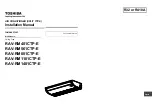
– 5 –
• Appliance and pipe-work shall be installed, operated and stored
in a room with a
fl
oor area larger than
A
min
m
2
.
How to get A
min
m
2
: A
min
= (M / (2.5 × 0.22759 × h
0
))
2
M is the refrigerant charge amount in appliance in
kg
;
h
0
is the installation height of the appliance in
m
:
0.6 m for
fl
oor standing / 1.8 m for wall mounted / 1.0 m for
window mounted / 2.2 m for ceiling mounted.
(R32 refrigerant models only. For detail, refer to Installation
Manual of the outdoor unit.)
Installation
• When the indoor unit is to be suspended, the designated
hanging bolts (M10 or W3/8) and nuts (M10 or W3/8) must be
used.
• Install the air conditioner securely in a location where the base
can sustain the weight adequately. If the strength is not enough,
the unit may fall down resulting in injury.
• Follow the instructions in the Installation Manual to install the
air conditioner. Failure to follow these instructions may cause
the product to fall down or topple over or give rise to noise,
vibration, water leakage or other trouble.
• Carry out the speci
fi
ed installation work to guard against the
possibility of high winds and earthquake. If the air conditioner is
not installed appropriately, a unit may topple over or fall down,
causing an accident.
• If refrigerant gas has leaked during the installation work,
ventilate the room immediately. If the leaked refrigerant gas
comes in contact with
fi
re, noxious gas may generate.
• Use forklift to carry in the air conditioner units and use winch or
hoist at installation of them.
Refrigerant piping
• Install the refrigerant pipe securely during the installation
work before operating the air conditioner. If the compressor
is operated with the valve open and without refrigerant pipe,
the compressor sucks air and the refrigeration cycles is over
pressurized, which may cause an injury.
• Tighten the
fl
are nut with a torque wrench in the speci
fi
ed
manner. Excessive tighten of the
fl
are nut may cause a crack in
the
fl
are nut after a long period, which may result in refrigerant
leakage.
• After the installation work, con
fi
rm that refrigerant gas does
not leak. If refrigerant gas leaks into the room and
fl
ows near
a
fi
re source, such as a cooking range, noxious gas may be
generated.
• When the air conditioner has been installed or relocated,
follow the instructions in the Installation Manual and purge
the air completely so that no gases other than the refrigerant
will be mixed in the refrigerating cycle. Failure to purge the air
completely may cause the air conditioner to malfunction.
• Nitrogen gas must be used for the airtight test.
• The charge hose must be connected in such a way that it is not
slack.
9-EN
10-EN







































